- Reclaim Your Fitness After 40
- Fitness After 40 – Your weekly fitness plan must incorporate:
- Fitness After 40 – Types of Exercises:
- Aerobic Exercises
- Anaerobic Exercises
- Isometric Exercises
- Isotonic Exercises
- Isokinetic Exercises
- Plyometric Exercises
- Calisthenics
- Flexibility Exercises
- Mobility Exercises
- Balance & Stability Exercises
- Choosing the Right Exercise Routine for Fitness After 40
Many of us do not give enough importance to health and fitness when we are young, but it is not an option after we cross 40. Fitness after 40 becomes essential because our bodies undergo significant changes, including a slowdown in metabolism, hormonal decline, loss of muscle mass, joint stiffness, and other lifestyle-related disorders. The only way to maintain fitness after 40 is by making positive lifestyle choices that include regular workouts, a healthy diet, and proper rest.
Reclaim Your Fitness After 40
The problem with people after 40 is that they often lack the confidence to reclaim their health and fitness, which is why many of us end up not doing anything about it. Desiring for good health and wellness is a good thing, but it is of no use to you unless you walk the path of fitness after 40. As someone once said, “The best time to start was yesterday, the second-best day is today.”
In this post, I will break down different types of exercises and their benefits to help you make the right choices to achieve your fitness goals. When it comes to exercises, there are no hard and fast rules on what to do and what not to do. What works for one person may not necessarily work for you. Even though the fundamentals of a plan are sound, you will need to tweak it to fit your requirements and capacity. It has to be a personalized plan that incorporates different types of exercises that offer you the best benefits. Of course, your plan should be flexible to accommodate changes and help you achieve higher fitness levels.
Fitness After 40 – Your weekly fitness plan must incorporate:
- Strength training
- Cardiovascular exercises
- Flexibility and mobility training
- Balance and stability.
It is important to look at all-round fitness after 40 rather than focusing only on individual aspects. For example, just running every day won’t necessarily yield the best results. You are likely to injure yourself because your muscle mass declines at a faster rate after 40. You need strength training to counter the muscle loss. Similarly, strength without mobility is also a recipe for potential injuries, and you cannot increase your mobility range of motion if your body is not flexible enough. Our body has several small stabilizer muscles that help us balance and maintain equilibrium during workouts and in our everyday activities. You cannot focus only on your big muscles and ignore the stabilizer muscles.
As you can see, your workout plan must address strength, cardiovascular health, mobility, flexibility, and balance as they all contribute to your overall fitness. You must plan your fitness program with a holistic approach to improve your performance capabilities and longevity. Now, let’s check out different types of exercises to understand their fundamentals. It will help you know your exercise options and make informed choices to suit your specific needs.
Fitness After 40 – Types of Exercises:
- Aerobic Exercises
- Anaerobic Exercises
- Isometric Exercises
- Isotonic Exercises
- Isokinetic Exercises
- Plyometric Exercises
- Calisthenics
- Flexibility Exercises
- Mobility Exercises
- Balance & Stability Exercises
If you are serious about fitness after 40, consider trying different exercise variations and combinations, as each one offers its own set of benefits.
Aerobic Exercises
Aerobic exercises involve continuous, rhythmic movements that elevate your heart rate and keep your body in motion for extended periods. As your heart rate stabilizes and your muscles warm up, you’ll naturally fall into a steady rhythm that supports endurance and flow. These workouts are performed at moderate intensity for longer durations, where your body uses more oxygen to generate energy.
A good rule of thumb: if you can speak complete sentences without gasping, you’re likely in the optimal aerobic zone. It is just an indicator that you are in the correct heart zone but focus on your form and rhythm instead of talking much. You can start with 20-minute sessions if you are a beginner and then scale it up as your strength and fitness levels go up.
Benefits of Aerobic Exercises:
- These exercises help you engage your leg muscles, core, back, shoulders, and arms.
- Aerobic Exercises are great for improving your heart rate and blood circulation in the body.
- Improves your lung capacity and enhances breathing.
- Helps to increase the endurance levels of your muscles, enabling them to work continuously without causing fatigue.
- If your goal is weight loss or fat burning, you cannot ignore aerobic exercises. They help to boost your metabolic activities and increase caloric absorption.
- It also helps improve blood sugar absorption and insulin sensitivity.
- Improves your cardiovascular health and slows down age-related decline.
- Supports brain health, builds mood (by releasing endorphins), and improves cognitive functions.
- These exercises are great for improving your muscle endurance and body stability.
- Enhances your ability to perform daily tasks with ease and sustained energy.
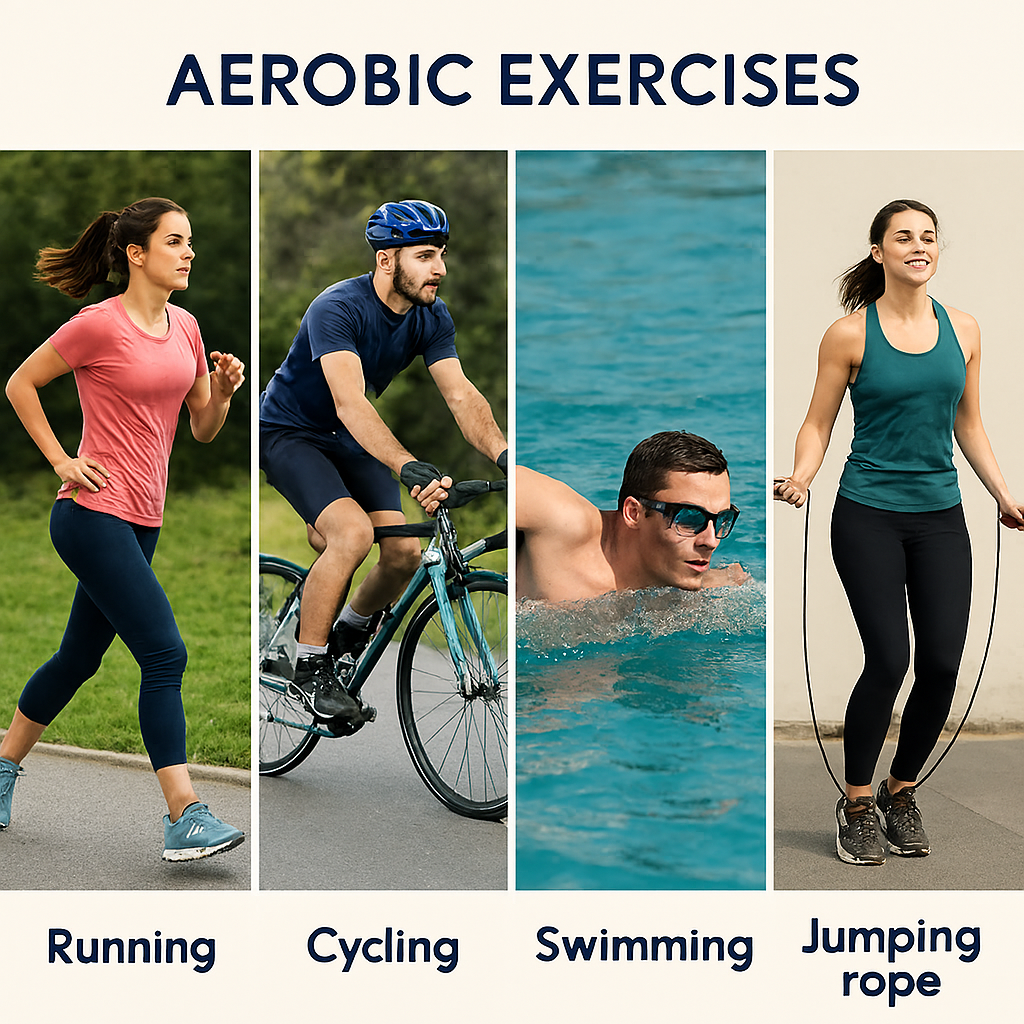
Some of the best aerobic exercises are running, cycling, brisk walking, swimming, and dancing. If your joints are not strong enough to handle the impact of running, consider using elliptical trainers or cycling for your aerobic exercises. Make sure you start slow and increase the intensity as your muscles grow stronger. Also, make sure that you incorporate strength and mobility workouts to improve performance and reduce injury chances.
Anaerobic Exercises
These are short-duration exercises that require bursts of strength and intensity. Anaerobic workouts will push your heart rate to mostly Zone 4 and Zone 5, where you have to work hard to break your physical threshold. Here, the body uses glucose to generate energy, rather than oxygen. This process is called anaerobic glycolysis, where the stored glucose in your muscles is converted to energy. These workouts may last for a few seconds to a couple of minutes, mostly pushing your muscles to their limits until failure.
Because oxygen intake is insufficient during these intense bursts, lactic acid builds up in the muscles, leading to that familiar “chest burn.” Anaerobic exercises often leave you breathless and grunting, because your body is working hard under high muscular tension. You will feel the lactic acid buildup because insufficient oxygen intake will not remove it efficiently. These exercises will make you grunt and leave you gasping for breath. Anaerobic Exercises will make you feel the burn and fatigue because you subject your muscles to considerably high tension.
Benefits of Anaerobic Exercises:
- Your body will experience sarcopenia, which is age-related muscle mass decline, but anaerobic exercises can effectively help in countering or slowing it.
- Anaerobic exercises are also great for fat burning as they help to increase the rate of metabolism when resting.
- Our bones tend to lose their density and become more porous and brittle after our 40s. It is called osteoporosis, but anaerobic exercises can help to counter it by strengthening the bones and reducing the risks.
- Anaerobic exercises place a lot os emphasis on joints and muscles around them. These exercises help to improve the functioning of our joints, providing better support and stability to our bodies.
- High-intensity interval training also works towards improving yout cardiovascular capacity, and reducing blood pressure.
- Helps you regulate blood sugar and improves insulin sensitivity.
- Help you become more agile and strong, making it easier to generate power even while doing your everyday tasks.
- Stimulates the production of testosterone and growth hormone.
- Reduces stress and improves mood with the release of endorphins.
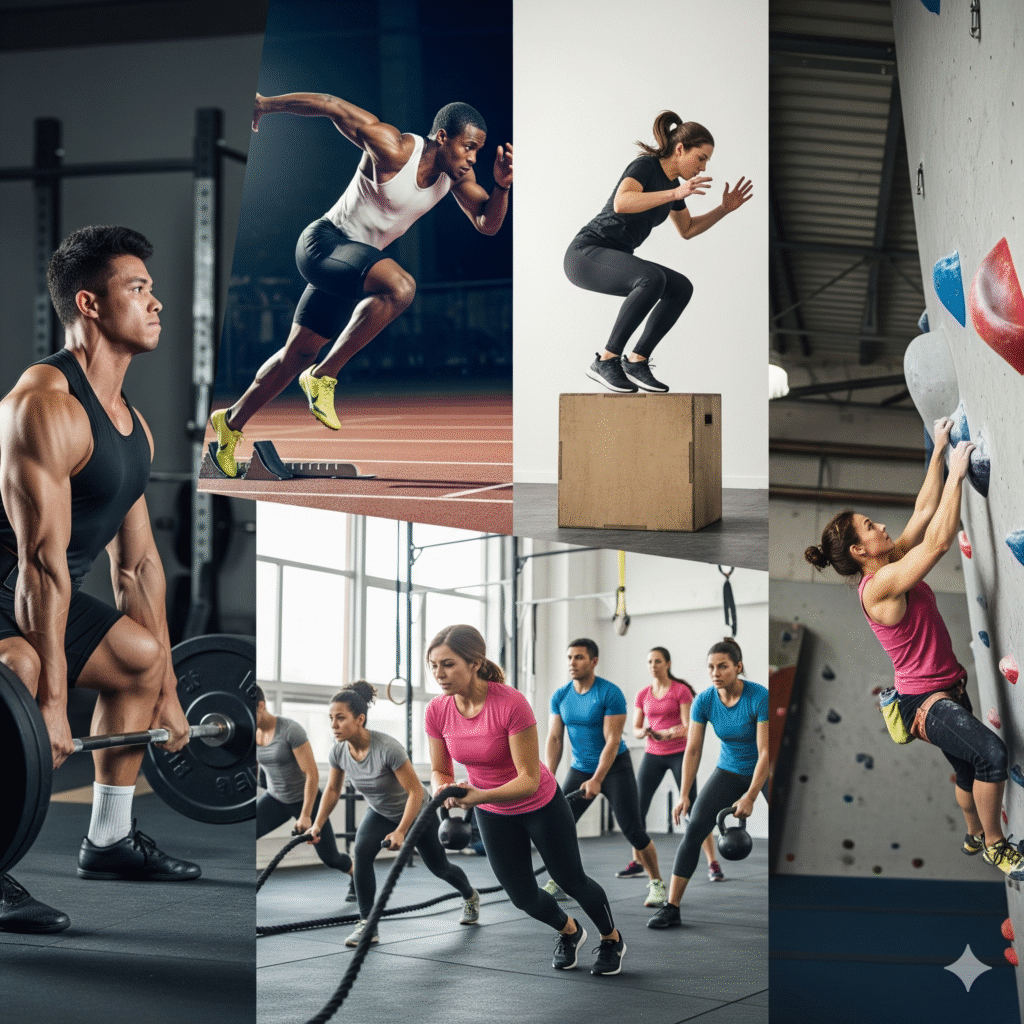
Some of the popular anaerobic exercises include weightlifting (e.g., deadlifts, weighted squats, and bench press), sprinting, high-intensity interval training (HIIT), jumping exercises, battle ropes, kettlebell swings, stair sprints or uphill runs, and plyometric exercises such as explosive push-ups or jumping lunges.
Isometric Exercises
Isometric exercises involve holding a stretched position and sustaining the muscle and joint tension for an extended time. They involve muscle contraction without moving the joints. The length of the muscle remains constant, and tension is applied to stretch the muscle length.
Isometric exercises involve holding a stretched position under tension for an extended time, typically lasting 30 seconds or more. You will not be moving the joints during the stretch. The muscles contract and generate force, but their length remains constant. These exercises build strength and stability by engaging muscles in a static hold for extended durations.
Benefits of Isometric Exercises:
- Isometric exercises are great for improving your muscle endurance and stability.
- It promotes joint health and stability, which is all the more important for people after 40.
- Isometric exercises provide a low-impact workout option, where joint stress is reduced while effectively challenging the muscles.
- Isometric exercises like planks and wall sits allow you to engage multiple muscle groups simultaneously.
- Once you develop static stability and strength, you can modify these exercisesinto dynamic movements.
- These exercises help to develop a strong sense of mind-muscle connection and improve cognitive abilities.
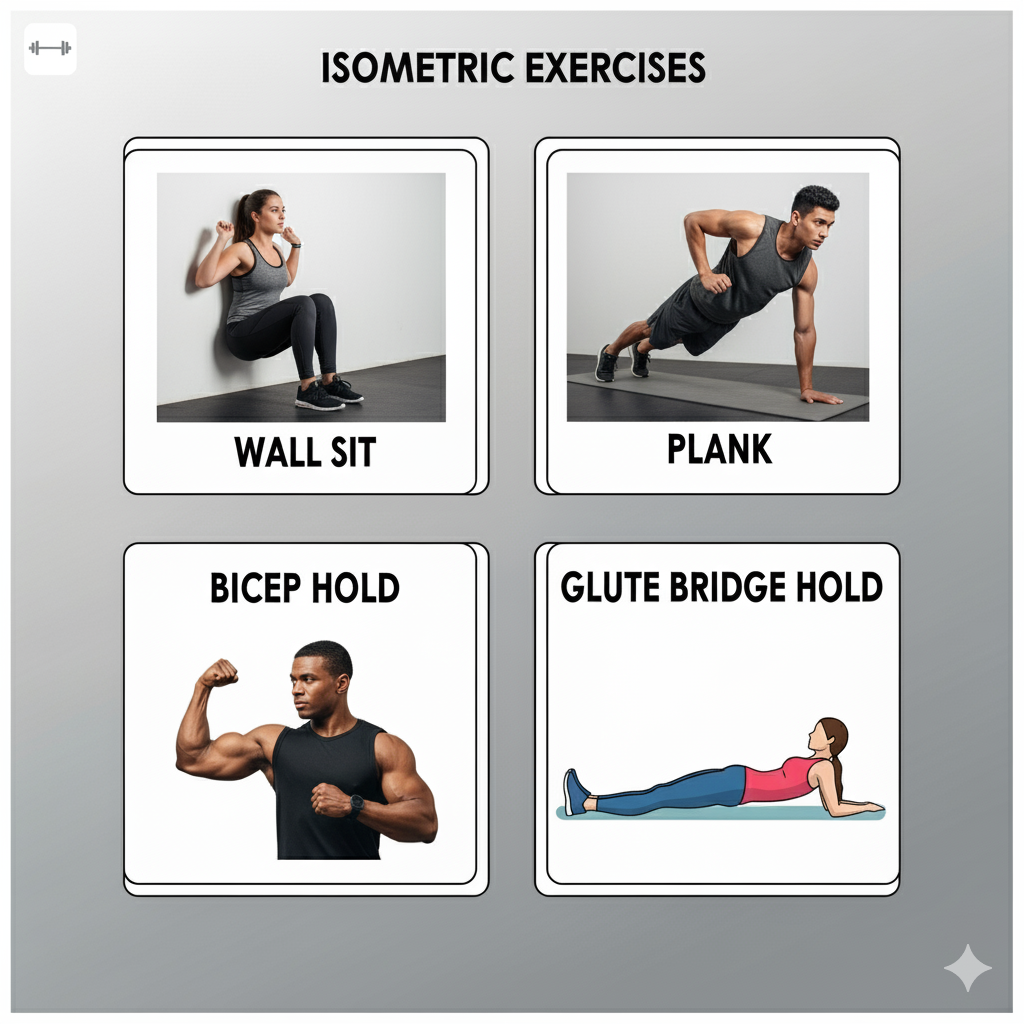
These exercises can be modified to incorporate dynamic moves once you’ve perfected the static poses. Yoga is a great way to adopt isometric exercises. It has hundreds of isometric poses that help align muscles, tendons, and joints, adding significant stability and flexibility to your body. Most of these exercises do not require equipment or weights, making them suitable for home and travel workouts.
Isotonic Exercises
Isotonic exercises are dynamic movements that involve muscle contraction and expansion. Here, you will move the corresponding joints through a range of motion to accommodate the movement of muscles. These exercises provide dynamic activities where the muscles are lengthened (eccentric) and shortened (concentric). Isotonic exercises are ideal for building strength, flexibility, and functional mobility.
Benefits of Isotonic Exercises:
- These exercises improve strength, flexibility, and muscle coordination.
- For individuals over 40, isotonic exercises offer improved joint mobility and increased muscle mass.
- These exercises stimulate bone health by promoting bone density, which becomes increasingly important as the risk of osteoporosis rises with age.
- Isotonic exercises also contribute to enhanced cardiovascular health, thus preventing heart-related issues commonly associated with ageing.
- Isotonic exercises help improve your metabolic activity, which in turn boosts your energy levels and aids in weight management.
- These exercises help to improve your functional fitness, making everyday activities easier.
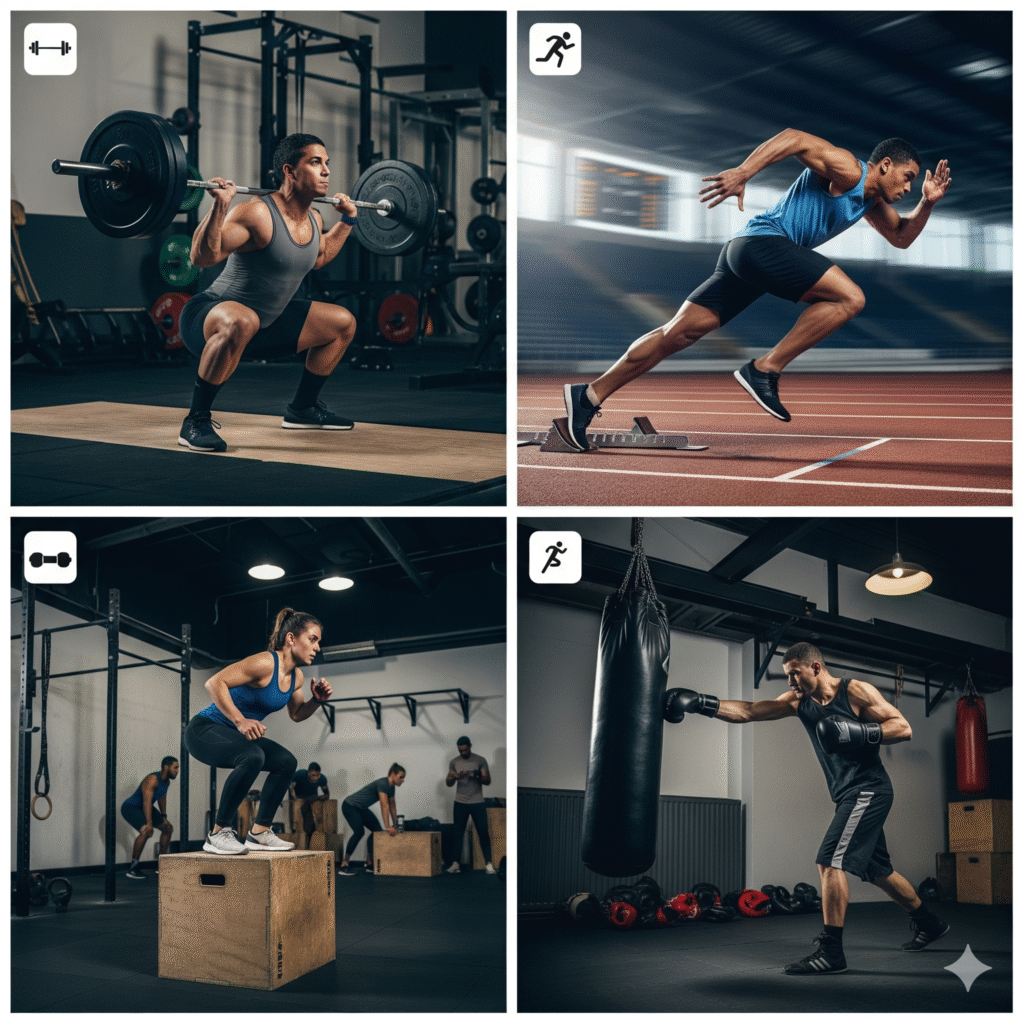
Some of the popular isotonic exercises include squats, lunges, bicep curls, push-ups, pull-ups, dumbbell rows, overhead press, triceps dips, bench press for chest, step-ups, calf raises, sit-ups, crunches, burpees, kettlebell swings, deadlifts, hammer curls, leg press machine, hamstring curls, mountain climbers, farmer’s carries, and many more.
Isokinetic Exercises
Isokinetic exercises involve specialized machines that maintain a constant speed of your movement while adjusting resistance to match your effort. In these exercises, you will be maintaining a constant speed while focusing on working a single joint across its wide range of motion. These exercises are especially helpful in rehabilitating from injuries, but fitness specialists or trainers also use these resistance-controlled exercises for assessing the muscle strength of athletes. These Isokinetic workouts are associated with using machines, usually at therapy clinics or sports injury diagnosis labs. However, some exercises are inspired by the isokinetic functions that you can do at home. I will talk about it later in this section.
Isokinetic movements typically involve concentric (muscle shortening) floowed by eccentric (lengthening) phases. In some cases, they may include an isometric hold, where you lock the joint position while the muscle remains under tension without changing length.
Benefits of Isokinetic Exercises:
- Safe: The primary advantage of these isokinetic exercises is for recovery because these machines do not overload you when your muscles are subjected to constant tension. They adjust to your energy output and will automatically reduce the stress when they sense weakness at any point during the range of motion.
- Accurate Strength Assessment: These machines can identify when your power produces the highest torque and also the lowest. It allows trainers or sports doctors assess the muscle strength of individuals accurately.
- Adaptable to Everyone: These workouts can be customized according to the personalized needs and capacities of individuals. The target muscles can be engaged precisely by adjusting the speed, load, and range of motion, thereby allowing people to recover without aggravating the injury.
Some of the best examples of isokinetic exercises are knee extensions followed by flexion, rotation or resistance training of shoulder movements, and dorsiflexion followed by plantarflexion of the ankle. As you can see, now isokinetic movements are more like single joint isolation training and not full body workouts, which are beneficial for strength assessment, healing, and recovery from injuries. If you have healthy joints and muscles, you will need to focus more on isotonic, isometric, or weighted functional movements to improve your performance levels.
Isokinetic-Inspired Home Exercises for Fitness after 40
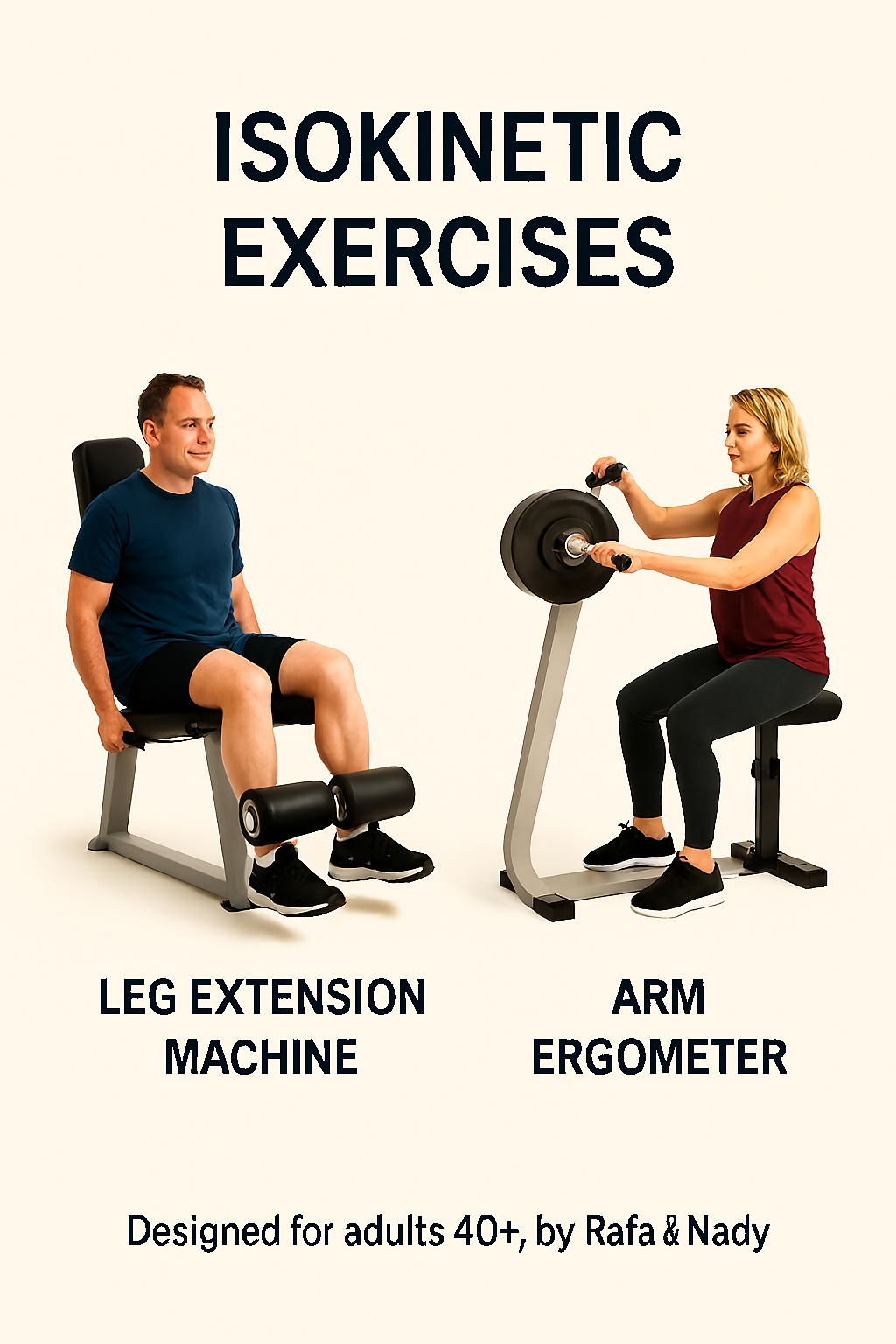
While true isokinetic training requires machines, you can simulate its principles at home using controlled resistance and tempo. You don’t need to visit a clinic or use sophisticated machines to do them. These exercises will help you simulate the movements of isokinetic exercises and help you develop strength, balance, and joint stability for performing other full-body exercises. Some of them include resistance bands with tempo control, manual resistance with a partner, self-resisted movements, and tempo-based weight exercises. Some variations of yoga or Pilates can help you get movements resembling isokinetic principles.
Plyometric Exercises
Modern lifestyles discourage physical activity, with hours spent in front of TVs, computers, and mobile screens. Our bodies tend to lose strength, mobility, and balance due to the effects of aging and sedentary lifestyles. A spontaneous movement, such as an awkward twist or sudden reaction, can easily lead to muscle tears and damage to connective tissues and joints. This conclusion was corroborated by a University of Bath study, which found that activities like dancing and athletics had remarkably low rates of serious injuries compared to common daily mishaps.
When you cross 40, there is a higher chance of injuries happening while doing or overdoing some daily activity. Among older adults, common reasons for seeking emergency care include slips, falls, and sharp pains triggered by sudden, awkward movements, even during routine tasks. As you age, your movement speed naturally declines, and the fast-twitch muscle fibers responsible for explosive actions tend to become weak from underuse. This decline reduces your ability to react quickly or move with power.
Preparing your body for explosive moments for Fitness after 40
One of the most effective ways to prevent these injuries and enhance your physical performance is by preparing your body for explosive moments. Training your muscles, joints, and connective tissues to handle explosive movements can significantly reduce injury risks and boost your overall performance. This is where plyometric exercises play a crucial role. These exercises are designed to complement your mobility workouts, reactivate explosive strength, and improve dynamic control, providing a secure foundation for your fitness journey.
Plyometric exercises are performed by targeting the fast-twitch muscle fibers with quick and explosive movements. These movements rely on the stretch-shortening cycle (SSC), where muscles rapidly lengthen and then contract, enabling you to generate maximum force in a short time.
Benefits of Plyometric Exercises:
- Plyometric training helps to improve your power output for sprinting, jumping, and making quick directional changes.
- These SSC exercises help enhance body coordination, reaction time, and agility through neuromuscular activation.
- When combined with strength training, plyometrics help to build sport-specific speed and explosive strength.
- Plyometric training is a crucial component for those who engage in intense sports such as football, volleyball, basketball, and athletics.
- Plyometric exercises are not only beneficial for performance enhancement but also play a significant role in injury rehabilitation programs. However, it’s essential to start with low intensity to help restore neuromuscular control, gradually increasing the intensity as muscle action improves.
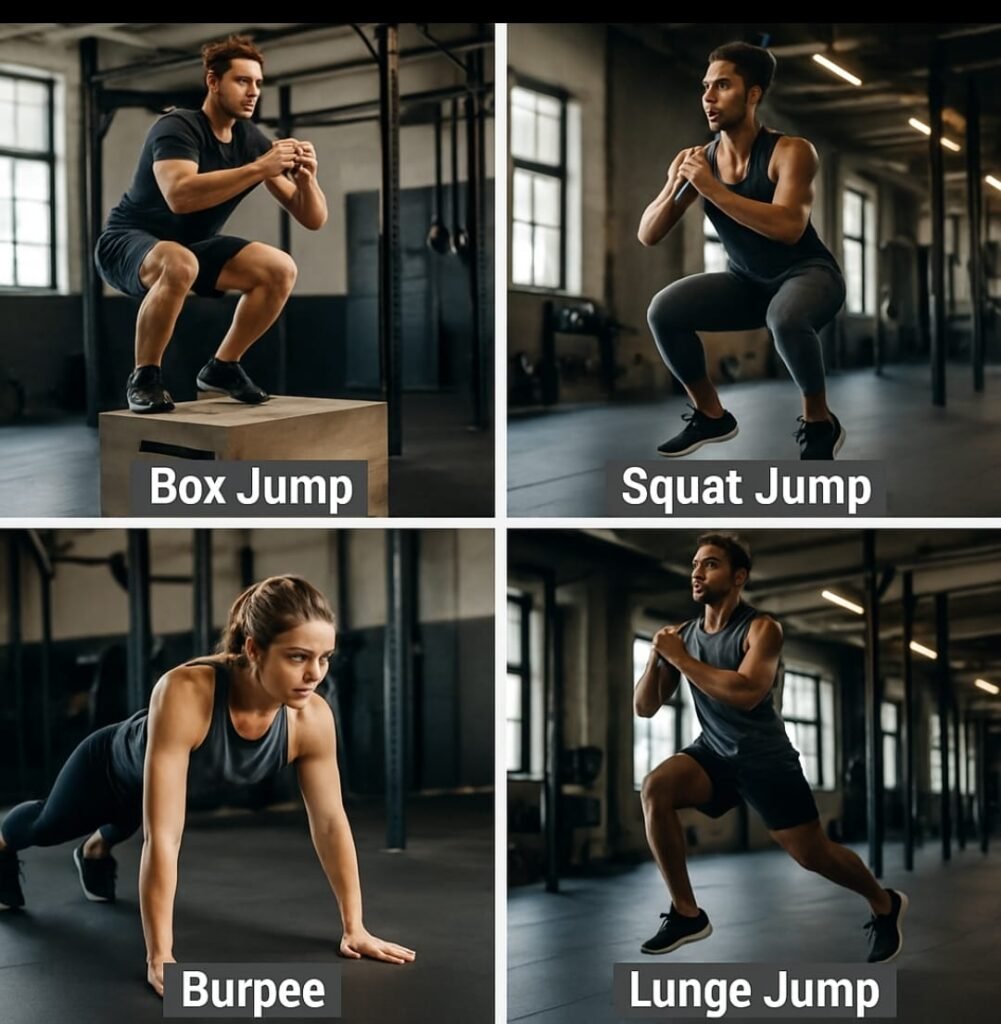
Some of the best examples of plyometric exercises are jump squats, box jumps, plyometric push-ups, depth jumps, lateral bounds, single-leg box jumps, clapping push-ups, medicine ball chest pass, overhead slam, burpee box jumps, high knee skips, squat thrusts, tuck jumps, dot drills, hurdle hops with pause, quick feet ladder drills, and many more.
The variety and excitement of these exercises can keep your fitness routine engaging and fun. Those who are starting with plyometrics should begin with low-impact drills on softer surfaces, such as grass, sand, padded flooring, or mats. It’s always advisable to consult with your doctor before starting these exercises, especially if you have any existing joint pain in your ankles, hips, knees, or back.
Incorporating plyometrics into your routine – Even one or two sessions a week can help you reclaim your explosive strength, reduce injury risks, and help you move with confidence at any age.
Calisthenics
Calisthenics offers the benefits of both strength and mobility workouts without the use of major equipment. These exercises are primarily performed using the resistance from body weight and gravitational force. Some of the advanced movements in calisthenics appear surreal when performed by experts, leading people to believe that only those with superhuman strength can achieve them. It makes them doubt their ability to achieve such agility and physical capability.
Calisthenics is not just for those with superior strength and natural talent. Like any other exercise program, it’s accessible to all. You can start with easier versions of exercises, such as push-ups, pull-ups, squats, lunges, and planks. With the support of props like resistance bands and yoga blocks, you can build your strength and technique. As you progress, you’ll find yourself removing these props, a clear sign of your growing capability.
You can then work towards complex movements with progressive overload, a principle where you gradually increase the intensity of your workouts to challenge your body and stimulate muscle growth continually. It may take months and even years to master them. To perform advanced calisthenics moves, the primary focus should be on developing strength, mobility, control, balance, and technique.
Benefits of Calisthenics Exercises:
- The movement patterns of calisthenics help build full-body functional strength, enabling individuals to perform real-life activities with ease.
- Calisthenics places a lot of emphasis on developing mobility and flexibility. You will be able to unlock some of the advanced calisthenics moves only after improving on these factors.
- You will notice a remarkable improvement in the range of motion and muscular control of your joints if you are consistent and dedicated to the program.
- These exercises help fine-tune your body coordination and neuromuscular efficiency, allowing you to hold body loads in different positions with remarkable balance and precision.
- Calisthenics help you improve your focus and body awareness, which in turn supports your mental well-being and promotes discipline.
- One of the significant advantages of calisthenics is its accessibility. Whether you’re at home or on the road, you can easily fit in a session. With no need for major equipment, you can even pack small props, such as rings and resistance bands, in your travel bag, ensuring your workout routine stays on track.
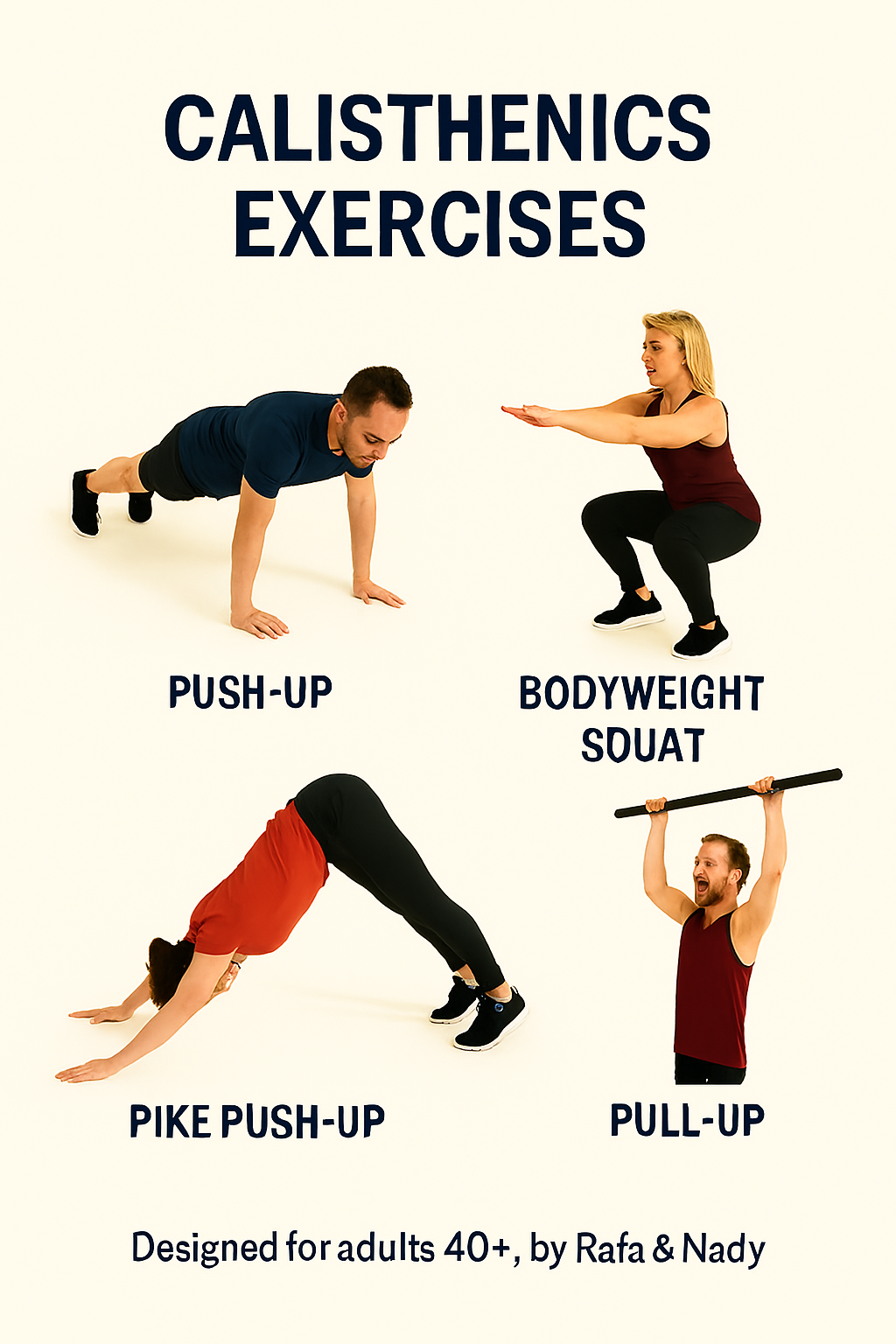
Calisthenics is not just for those who are naturally gifted with superhuman strength and mobility. Anyone interested can start with simpler variations and strengthening drills, but your progress will depend solely on your dedication and the amount of time and effort you invest. As I mentioned earlier, mastering advanced moves may take months or even years.
Calisthenics offers a wide range of exercises, from the familiar Push-ups, Pull-ups, Squats, Lunges, Dips, Planks, Sit-ups, and Burpees, to more advanced skills like Muscle-ups, Front lever, Planche pushups, Human flag, pistol squats, handstands, inverted straddle lifts, Sissy squats, levers, and more. As you build strength and technique, you can progress to these advanced moves, adding variety and challenge to your workouts.
Calisthenics and lower-body muscles
Calisthenics focuses more on core and upper body muscles, so it may not be as effective as weight training exercises for building big muscle mass in the legs. You will need to do some specific weight training to balance the lower-body hypertrophy.
You must have a proper, structured plan to make progress in calisthenics, but you can also try some creative variations when you gain strength and confidence. The most important thing to remember here is that you will be subjecting your joints and wrists to tremendous stress, which is why it is critical to never skip the warm-up and mobility drills before starting. Aim to progress gradually by mastering one step at a time and avoid skipping over important steps in the process.
Flexibility Exercises
Strength without flexibility will eventually lead to injuries. If weight training helps increase the width of our muscles, flexibility exercises help extend the length or elongate the muscles and connective tissues at the joints. Your muscles must be well elongated to allow for a full range of motion in your joints.
Tight muscles prevent you from moving your arms and legs efficiently. Your shoulder may feel the strain even while performing a simple task, such as reaching the upper back with your palm. Therefore, flexibility training is essential for enhancing functional fitness, which is crucial for performing our daily activities.
If you are looking for lifelong fitness, incorporating flexibility exercises into your strength and cardio workouts is essential. These are stretching exercises that many runners tend to ignore. Whether you are a runner, cyclist, football player, or bodybuilder, flexibility training will add a new dimension to your training regimen and help you improve your performance.
I am not talking about the 10-minute warm-up drills or cool-down stretches. You must dedicate at least 1 hour to a stretching session at least once or twice a week. I practice a 75-minute Yoga session at least once a week, and I can vouch for the fact that it has transformed my running. My strides are more fluid as I feel the enjoyment of my knees and ankles working like a well-oiled machine.
Yoga is a weekly body realignment program for me, as I can see the difference in my strides the next day. I would rate hip opening stretches among the top flexibility exercises for runners. What started as a curiosity has now become a non-negotiable part of my weekly fitness plan.
Running is a dynamic sport where your legs are super active, but it is still a full-body activity. You need good flexibility in your ankles, knees, hips, and shoulders to maintain your form. Loss of form in the session is an invitation to injury, which is why you cannot ignore flexibility exercises for runners for fitness after 40.
Benefits of Flexibility Exercises:
- Flexibility exercises help in improving the elasticity of muscles which in turn allows for significant improvement in the range of movement of your joints.
- Overly tight muscles can lead to body imbalance, but you can restore your balance with proper stretching routines.
- You can significantly reduce the risks of injuries like sprains and strains by developing flexible muscles.
- Flexibility exercises help to realign the body posture by removing the tension from frequently used muscles.
- Flexibly drills are a part most sports because they help to improve the efficiency of our movements, thereby allowing to refine techniques and performances.
- Our body relaxes from stress when the parasympathetic nervous system gets activated during stretching. You will feel a satisfying sense of calm after the session and your mind will be stress-free for many hours after that.
- Stretching exercises also help in post workout recovery as they help to improve the blood circulation in the muscles.
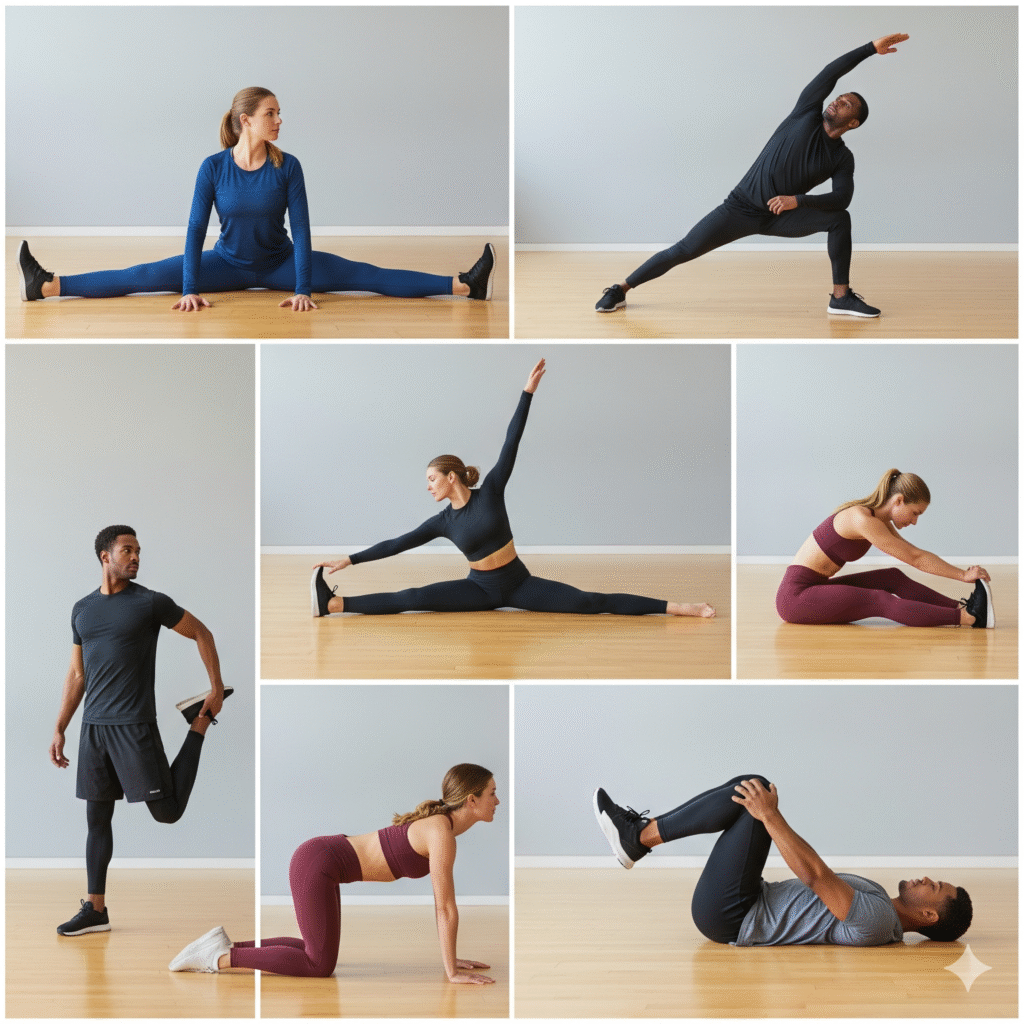
There are many variations of flexibility exercises, such as static stretching, dynamic stretching, active stretching, passive stretching, PNF stretching, ballistic stretching, isometric stretching, etc. Your flexibility training sessions should ideally include static and dynamic stretching. I alternate the same muscle group or joint with both static and dynamic stretches. Static stretches teach your nervous system that you can safely reach a certain stretch range, while dynamic stretches help you work on the mobility for that new range. You must identify the flexibility needs of your joints to plan your stretching routine for over 40.
Flexibility exercises are non-negotiable for Fitness After 40
Remember that flexibility improvement takes much more time than muscle building. Sometimes, I feel that I have made only 1-2 mm progress after a few months, maybe because I do only 1 session a week. Nevertheless, it does make a big difference to my running form and balance. I am sure you will see better results by doing more sessions than I currently do. If you aim to live a healthy life with good fitness after 40, the flexibility exercises are non-negotiable. You will hit the roadblock at some point if you ignore this advice.
Mobility Exercises
If you aim to improve your fitness after 40, then you must give equal importance to mobility in addition to strength and endurance. It helps to enhance your fitness by improving the range of motion in your joints. Mobility exercises help you build balance, stability, and efficient muscular control.
Many people confuse mobility and flexibility as the same thing, but they are distinct from each other. Mobility can be seen as the vital middle ground between strength and flexibility. The primary difference lies in their active and passive nature. While you need to move and stretch repetitively to touch the end range in mobility exercises, you have to stay passively in the end range for flexibility exercises. Mobility exercises are dynamic or isotonic, while flexibility exercises are static or isometric.
If you are only flexible but not mobile, you will likely encounter limitations when moving. Mobility enables you to move with strength, control, and balance, and also helps prevent sports injuries. Mobility exercises make your body more functional and efficient for performing other physical activities beyond workouts.
Benefits of Mobility Exercises:
- Mobility exercises improve joint health by promoting lubrication, thereby enhancing your functional fitness.
- These exercises improve your movement patterns and muscle coordination, helping you prevent injuries while training or in your normal daily activities.
- Mobility training helps correct body balance and reverse overcompensation in specific muscles, leading to improved body alignment and posture.
- The mobility drills will help you improve your agility, speed, and strength, enabling you to excel in athletic activities.
- Mobility exercises help with soothing pain, and I can personally vouch for this fact. Some of the mobility exercises I learned helped me manage my pain and eventually make it disappear.
- Mobility training empowers you to age with strength, confidence, and freedom of movement.
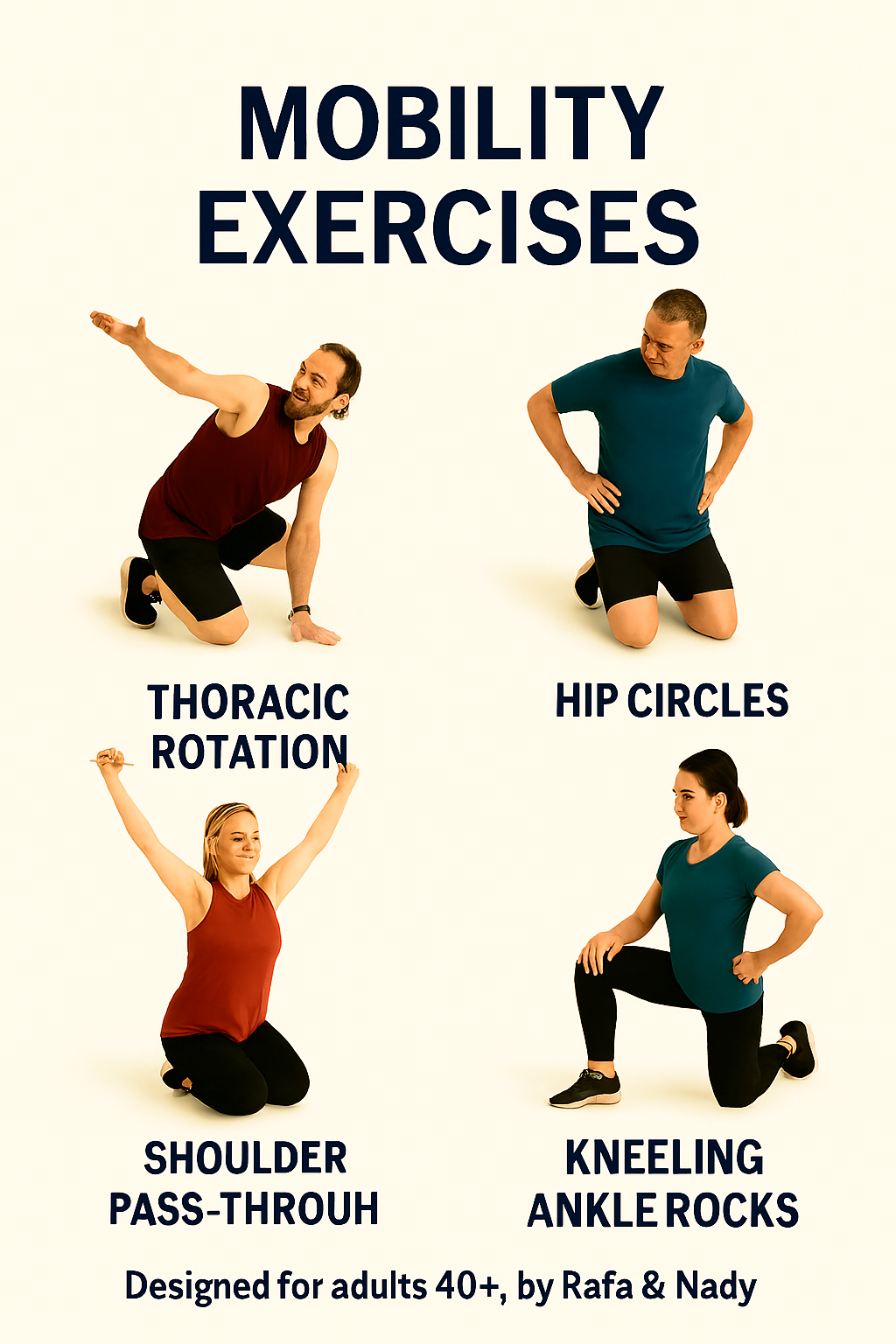
Some of the common types of mobility exercises are 90/90 hip rotations, Cossack squats, shoulder CARs, band assisted ankle mobilizations, dead hangs, kettlebell windmills, world’s greatest stretch, adductor rocking, toe touch to deep squat, cat-cow alternate, thread the needle, wall angels, tibialis raises, toe yoga, heel sit stretch, wall slides with foam roller, scapular push-ups, PVC shoulder pass-throughs, dynamic lunges, animal flow, and many more.
So how to incorporate mobility into your routine? Mobility exercises are versatile, and you can do them before or after workouts, on rest days, or even during injury. rehabilitation. This flexibility makes it easier to stay consistent and motivated in your fitness journey. Start with just 5 minutes a day, and you’ll be amazed at how your body responds. Your future self will thank you
Balance & Stability Exercises
No matter what kind of workouts you do – strength, cardio, yoga, or sports, balance and stability are the silent foundations. Without them, even the best routines can lead to poor form, muscle imbalances, or injury over time.
It’s great that you’re staying active with regular workouts, but without proper techniques, even consistent workouts can backfire. You are likely to adopt wrong techniques, which could slowly become a habit and go all the way to injure you, or you may end up weakening some muscle(s) on one side. You may not realize it, but you are slowly losing your balance and stability.
I work on improving my body balance to identify where I lack the necessary strength to maintain a posture. Whether it is while standing on one leg or while running, body balance and joint stability are essential for everyone who engages in any form of exercise. It is technically just not possible to build your strength, endurance, and mobility without proper body balance. I have been running regularly for more than 17 years now, and I can tell you that people must pay attention to their body stability, especially after they cross 40.
Knowledge or awareness of your body balance will help you understand a great deal about your biomechanics, which is crucial for selecting the right exercises tailored to your personalized needs and capacities. So, cutting a long story short, you need balance and stability exercises to achieve holistic fitness, especially for those who choose the path of fitness after the age of 40.
These exercises involve movements or position holds that help strengthen and stabilize specific muscle groups. Some of the stability exercises focus on maintaining balance when an external force or stimulus is applied. Balance and stability exercises help train your neuromuscular system, or muscle memory, to coordinate your muscles and joints for performing various tasks. These exercises activate the deeper stabilizer muscles, providing complete control for your movements and also for holding static positions, such as standing on one leg.
Benefits of Balance & Stability Exercises:
- Balance and stability exercises help coordinate joints, muscles, and sensory signals to achieve better posture, whether while moving or staying still.
- Body balance is crucial for improving the efficiency of our movements, which helps prevent injuries while performing workouts or daily chores.
- Balance exercises are vital for improving body awareness, also known as proprioception, which helps prevent falls and related mishaps.
- By working on your balance, you improve the coordination between the musculoskeletal system and the nervous system.
- Stability exercises place a great emphasis on using our joints efficiently, helping them become stronger and preventing injuries.
- Balance and stability work is not just for sportspeople and athletes. It is also great for adults to boost their efficiency while performing everyday activities, such as climbing stairs, walking, picking up objects, reaching overhead, and lifting.
- Physiotherapists and sports doctors also recommend Balance exercises for individuals recovering from an injury or undergoing post-surgery therapy.
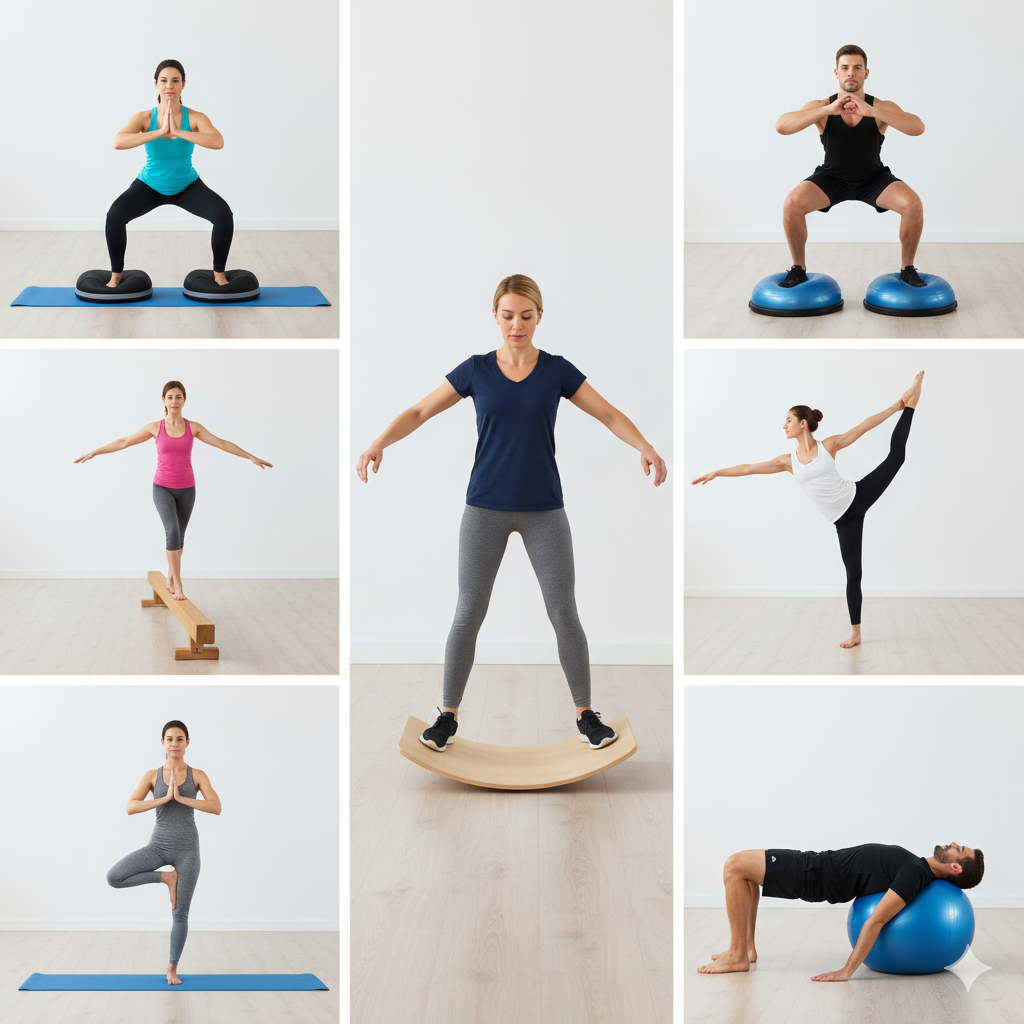
These stability and balance exercises can be categorized into static exercises (e.g., single-leg stand, tree pose), dynamic balance exercises (e.g., heel walking, single-leg squats), proprioceptive training (e.g., balance board drills, Bosu ball lunges), core-integrated balance (e.g., plank variations, dead bug exercise), and mind-body balance exercises (e.g., tai chi flow sequences, standing twists).
Flexibility exercise routine for Fitness After 40
According to fitness and sports research experts, it is ideal to work on balance and stability at least twice a week. The duration of the session will depend on your goal or purpose, as well as your fitness level. If you are unable to make time for these sessions due to your weekly cardio and strength training schedule, you can integrate them into your existing sessions.
You can introduce them in your warm-up and cool-down drills, or even during your everyday activities. For example, you can stand on one leg while waiting for someone or while brushing your teeth. The bottom line is that you can work on your balance and stability skills at any time. Start small. Pick one balance drill and weave it into your day. Your joints, posture, and future self will thank you.
Choosing the Right Exercise Routine for Fitness After 40
By now, it’s clear that no single exercise type holds all the answers to your fitness needs. Each form, whether focused on strength, endurance, mobility, or control, plays a distinct role in supporting your body’s evolving requirements. After 40, the goal isn’t just performance; it’s also about preservation, progression, and long-term sustainability.
To build a truly well-rounded routine, you’ll need to incorporate a variety of exercise types. Your approach should target different muscle groups, joints, and stabilizers to develop strength, endurance, and functional capacity. Beyond the physical benefits, varied training keeps sessions engaging, helping you stay motivated and consistent on your goal of fitness after 40.
A Balanced Plan for Fitness After 40 Must Help To:
- Protect your joints
- Preserve bone density
- Develop lean muscle mass
- Support metabolic and cardiovascular health
- Enhance coordination, flexibility, and balance
Why Variations Matters for Fitness After 40
The key for fitness after 40 is intentional variation. When your muscles adapt too quickly to repetitive workouts, progress stalls. Mixing up your training not only prevents plateaus; it keeps your mind stimulated, and your body challenged in healthy and sustainable ways.
Fitness after 40 isn’t about chasing extremes. It’s about building resilience, staying functional, and moving with purpose.
Respecting your body doesn’t mean avoiding challenge. It means being consistent, allowing time for recovery and adaptation, and gradually expanding your limits. With the proper foundation of strength, mobility, endurance, and balance, you’ll gain the confidence to pursue new goals and personal bests.
Take your time. Stay consistent. Keep showing up – Your strongest years are still ahead!
Reference 1 | Reference 2 | Reference 3 | Reference 4 | Reference 5 | Reference 6 | Reference 7 | Reference 8 |